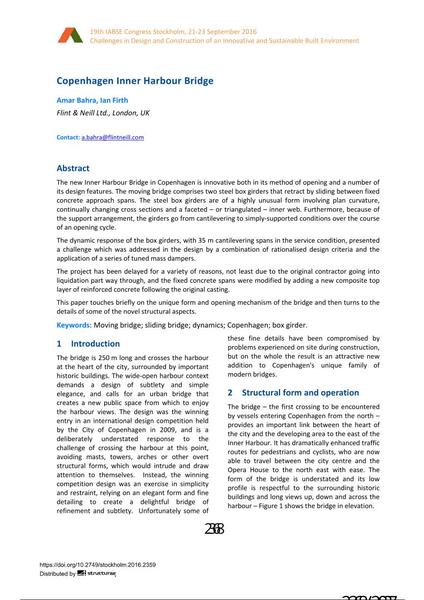Copenhagen Inner Harbour Bridge

|
|
|||||||||||
Bibliografische Angaben
| Autor(en): |
Amar Bahra
(Flint & Neill Ltd., London, UK)
Ian Firth (Flint & Neill Ltd., London, UK) |
||||
|---|---|---|---|---|---|
| Medium: | Tagungsbeitrag | ||||
| Sprache(n): | Englisch | ||||
| Tagung: | IABSE Congress: Challenges in Design and Construction of an Innovative and Sustainable Built Environment, Stockholm, Sweden, 21-23 September 2016 | ||||
| Veröffentlicht in: | IABSE Congress Stockholm, 2016 | ||||
|
|||||
| Seite(n): | 2368-2374 | ||||
| Anzahl der Seiten (im PDF): | 7 | ||||
| Jahr: | 2016 | ||||
| DOI: | 10.2749/stockholm.2016.2359 | ||||
| Abstrakt: |
The new Inner Harbour Bridge in Copenhagen is innovative both in its method of opening and a number of its design features. The moving bridge comprises two steel box girders that retract by sliding between fixed concrete approach spans. The steel box girders are of a highly unusual form involving plan curvature, continually changing cross sections and a faceted – or triangulated – inner web. Furthermore, because of the support arrangement, the girders go from cantilevering to simply-supported conditions over the course of an opening cycle. The dynamic response of the box girders, with 35 m cantilevering spans in the service condition, presented a challenge which was addressed in the design by a combination of rationalised design criteria and the application of a series of tuned mass dampers. The project has been delayed for a variety of reasons, not least due to the original contractor going into liquidation part way through, and the fixed concrete spans were modified by adding a new composite top layer of reinforced concrete following the original casting. This paper touches briefly on the unique form and opening mechanism of the bridge and then turns to the details of some of the novel structural aspects. |
||||
| Stichwörter: |
Hohlkasten bewegliche Brücke
|
||||


